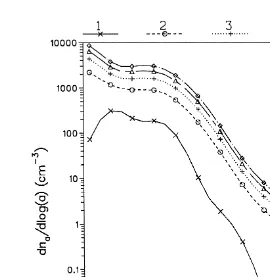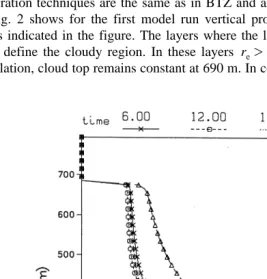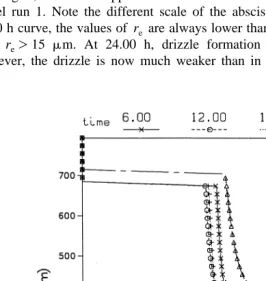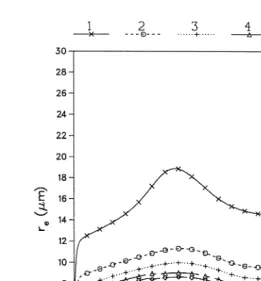www.elsevier.comrlocateratmos
A numerical model of the cloud-topped planetary
boundary-layer: influence of the physico-chemical
properties of aerosol particles on the effective
radius of stratiform clouds
Andreas Bott
)Institut fur Physik der Atmosphare, Johannes Gutenberg-Uni¨ ¨ Õersitat Mainz D-55099 Mainz, Germany¨
Abstract
The present investigation deals with the impact of different aeorosol types on the value of the effective radius of stratiform clouds. In several numerical sensitivity studies with the microphysi-cal stratus model MISTRA, the aerosol composition was linearly changed from pure maritime to pure rural aerosol particles. Numerical results show that in environments with pure maritime aerosols, the effective radius is usually much larger than in continental regions. Values of the effective radius are also time-dependent with minima and maxima during day and night, respectively. In precipitating clouds, the effective radius might achieve values larger than 30mm. In continental regions, the effective radius is relatively small with values below 10 mm. The numerical results also show that a small contribution of the rural aerosol to the total aerosol number concentration already has a strong impact on the value of the effective radius. According to these findings, it is recommended to use in large-scale models the lower continental values of the effective radius in all regions over the ocean which are affected by continental air masses. q2000 Elsevier Science B.V. All rights reserved.
Keywords: Cloud microphysics; Radiation; Boundary-layer clouds; Effective radius of clouds
1. Introduction
Ž .
Clouds play an important role for the earth’s radiation budget because 1 they reflect
Ž .
efficiently the incoming solar radiation and 2 they emit thermal radiation back to space
)Tel.:q49-6131-392862; fax:q49-6131-393532.
Ž .
E-mail address: [email protected] A. Bott .
0169-8095r00r$ - see front matterq2000 Elsevier Science B.V. All rights reserved.
Ž .
at a temperature different from the earth’s surface temperature. The difference between the radiation fields of a clear sky and a cloudy atmosphere is commonly referred to as cloud radiative forcing. This radiative forcing is of particular interest for studies of the
Ž .
global climate. By comparing 19 different general circulation models, Cess et al. 1990 found that a proper treatment of clouds is essential for producing reliable climate predictions.
The investigation of the impact of clouds on the global climate was the objective of
Ž . Ž .
the Earth Radiation Budget Experiment ERBE Barkstrom, 1984 and of the
Interna-Ž . Ž .
tional Satellite Cloud Climatology Project ISCCP Rossow and Schiffer, 1991 .
Ž .
Ramanathan et al. 1989 found from the ERBE data a negative radiative forcing of
Ž .
clouds, i.e., a net cooling of the atmosphere. Harrison et al. 1990 , also utilizing the ERBE data set, pointed out that among different cloud types, cirrus and marine stratiform clouds have the strongest impact on the radiation balance. For the interpreta-tion of satellite measurements, it is essential to know several cloud microphysical parameters, such as the cloud water content and the effective radius r of cloud droplets.e
Ž .
According to Hansen and Travis 1974 , the latter quantity is defined by:
`
whereby nw r is the spectral number distribution of cloud droplets with radius r. Due
to the lack of better information r is often assigned a constant value independent of thee
Ž .
microphysical structure of the clouds. Rossow et al. 1989 used res10 mm to infer cloud optical thickness from the ISCCP data. However, they mentioned that this
Ž .
assumption yields an error in the retrieved data of about 20%. Han et al. 1994 investigated the ISCCP data in order to obtain a more detailed information on cloud microphysical parameters. They found that the effective cloud droplet radius is not constant but it depends on the type of clouds, on the geographical region as well as on the season of the year. For a particular cloud type, r is also varying during the day.e
They also showed that the background aerosol number concentration plays an important role for the microphysical structure of the clouds. With increasing number concentra-tions of the aerosol particles, the reflectivity of the cloud is also increasing whereby at the same time, the effective radius is decreasing. These findings are in accordance with
Ž .
observations of Albrecht 1989 .
Ž .
Iwasaki and Kitagawa 1998, personal communication found clear evidence for a link between the aerosol type and the radiative forcing of clouds. By including in the global numerical weather prediction model of the Japan Meteorological Agency the different aerosol types over the ocean and over the land, they obtained a distinct improvement of the model results regarding the prediction of the Asian summer monsoon.
model MISTRA have been performed. The sensitivity studies consist of five different model runs. In each of the model runs, all initial data are the same with the only exception that the number concentration and the chemical composition of the aerosol particles differ in each model run. In Section 2, a short summary of the governing model equations of MISTRA will be given. In Section 3, the numerical results of the five model studies are presented while Section 4 summarizes the findings of the sensitivity studies.
2. Description of MISTRA
Since a detailed model description of MISTRA is already presented in Bott et al.
Ž1996. Žhenceforth abbreviated as BTZ , only a short summary of the governing model.
equations will be given here. The model is one-dimensional and consists of a set of prognostic equations for the ensemble mean values of the components u and Õ of the
horizontal wind, of the specific humidity q and the potential temperature u. In these equations, the most important processes being considered are vertical advection, turbu-lent mixing, radiative heating, condensationrevaporation and the collisionrcoalescence of cloud droplets.
In the microphysical part of the model, aerosol particles and cloud droplets are
Ž .
treated in a joint two-dimensional particle spectrum f a, r . The size distribution of the dry aerosol particles with radius a is subdivided into 30 classes with 0.01FaF10mm. In each of the 30 aerosol classes, the particles may grow due to the uptake of water
Ž .
vapor, thus, forming humidified aerosol particles or in case of their activation cloud droplets with total radius r. Along the r-coordinate, the particle spectrum is subdivided into 100 water classes with aFrF50mm yielding altogether a spectral distribution of
Ž . Ž .
3000 particles f a , ri j with different combinations of a , ri j is1, . . . ,30, js
Ž .
1, . . . ,100. Thus, a set of 3000 prognostic equations for f a , ri j describes the time evolution of the aerosol particles and cloud droplets. In addition to the processes mentioned above, gravitational settling of the particles and the collisionrcoalescence of droplets are also accounted for in these equations. The activation of aerosol particles to form cloud droplets, as well as their diffusional growth, are explicitly calculated by solving at all relative humidities 30 coupled droplet growth equations according to the subdivision of the particle distribution into 30 aerosol classes. Radiative effects are also included in the droplet growth equation. For more details about this treatment, see Bott
Ž .
et al. 1990 .
In general, aerosol particles consist of different fractions of water-soluble and water unsoluble material. Important water-soluble substances are sodium chloride, ammonium nitrate and ammonium sulfate. Water unsoluble substances are mineral dust, organic materials, etc. The chemical composition of an aerosol particle largely depends on the mechanisms of its formation. For instance, in the remote marine environment, aerosol particles mainly consisting of ammonium sulfate or ammonium bisulfate originate from
Ž .
components of the aerosol particles. Apart from their chemical composition, the total aerosol number concentration is also largely varying depending on their origin. From
Ž .
measurements of aerosol size distributions over the Atlantic Ocean, Hoppel et al. 1990 clearly identified a transition from continental to marine type aerosol particles whereby the total number concentrations were strongly decreasing with increasing distance from the continent.
In order to investigate the importance of the physico-chemical properties of aerosol particles on the evolution of stratiform clouds, in Section 2 the numerical results of five model runs with MISTRA will be presented. In each model run, the initial meteorologi-cal conditions are the same with the only exception that the aerosol size distribution will be different. Each of the utilized aerosol spectra is given by the sum of three log–normal
Ž .
In model run 1, a typical maritime aerosol spectrum will be used. For this case, the
Ž .
coefficients appearing in Eq. 2 have been determined in such a way that they fit with
Ž .
measurements of marine aerosol size distributions by Hoppel and Frick 1990 . These coefficients are given by:
na ,1s100 R1s0.027 logs1s0.25
na ,2s120 R2s0.105 logs2s0.11
Ž .
3na ,3s6 R3s0.120 logs3s0.45
The marine aerosols are assumed to consist of pure ammonium sulfate, i.e., they are
Ž . Ž .
completely water-soluble. The aerosol spectrum resulting from Eqs. 2 and 3 is depicted as curve 1 in Fig 1. For the chosen size range between 0.01 and 10mm, the total number concentration is 181 particles cmy3.
In model run 5, a typical rural aerosol size distribution will be utilized. The
Ž . Ž .
corresponding coefficients in Eq. 2 are Jaenicke, 1988 :
na ,1s6650 R1s0.0074 logs1s0.225
na ,2s147 R2s0.0269 logs2s0.557
Ž .
4na ,3s1990 R3s0.0419 logs3s0.266
The chemical composition of the rural aerosols is assumed to be a mixture of ammonium sulfate and mineral dust whereby the water-soluble fraction is linearly decreasing from 90% for the smallest to 50% for the largest aerosol particles. This size-dependent partitioning of the water-soluble and unsoluble mass fraction is based on
Ž .
measurements by Winkler 1974 . The resulting rural aerosol spectrum has a total number concentration of 3842 particles cmy3 and is given by curve 5 of Fig. 1. Model
Fig. 1. Aerosol size distributions of the five model runs.
Ž
of a mixture of the rural and the maritime size distribution with model run 2 75%
. Ž .
maritime and 25% rural , model run 3 50% maritime and 50% rural and model run 4
Ž25% maritime and 75% rural aerosols. The resulting total number concentrations are.
1097, 2012 and 2927 particles cmy3, respectively. The particle spectra are given as curves 2, 3 and 4 in Fig. 1.
In BTZ, it has already been mentioned that the activation of aerosol particles to form cloud droplets depends on their size and chemical composition as expressed by the Kohler equation:
¨
e a, r
Ž
.
A BS a, r
Ž
.
s sexpž
y 3 3/
Ž .
5es r r ya
Ž .
Here, e a, r is the equilibrium water vapor pressure at the particle’s surface and e iss the saturation vapor pressure over a plane water surface. Arr is the so-called curvature
Ž .
term describing the increase of e a, r due to the curvature of the particle’s surface
ŽKelvin effect , while B. rŽr3ya3.is the solution term yielding a reduction of the water
Ž .
vapor pressure due to dissolved salts within the particle Raoult’s law . The constants A
Ž .
3. Numerical results
Ž
The model runs to be presented in this section start at midnight local time 00.00 h in
.
the model simulations . With each aerosol size distribution, a 24-h run is performed. The initial vertical temperature profile at 00.00 h is given by a dry adiabatic stratified atmosphere in the lowest 700 m with the temperature at the first grid point equal to the sea surface temperature of 288.4 K. At 700 m, a strong temperature inversion of 8 K is applied. Above this inversion level, the lapse rate is set constant toy0.006 K my1. In
Ž . y1
the lowest 700 m, the initial specific humidity is qsmin q , 0.0085 kg kgs . Above the inversion level, qs0.004 kg kgy1. At the sea surface, the saturation specific
humidity q is utilized. In all layers, the initial horizontal wind speed is set equal to thes
Ž . Ž . y1
geostrophic wind of u ,g Õg s 6.0, 0.0 m s . The large-scale subsidence is held fixed
at y0.006 m sy1.The numerical discretization in space and time as well as the
integration techniques are the same as in BTZ and are, therefore, not repeated here. Fig. 2 shows for the first model run vertical profiles of the effective radius at the times indicated in the figure. The layers where the liquid water content exceeds 0.05 g my3 define the cloudy region. In these layers re)0. It is seen that during the model simulation, cloud top remains constant at 690 m. In contrast to this, the base of the cloud
is gradually decreasing, until the cloud touches the ground at midnight. This is due to the formation of drizzle, which at this time has already reached the ground. From the figure, it is also seen that r is increasing with decreasing height within the cloud. Thise
is explained by the fact that the concentration of the larger drizzle drops is increasing in lower cloud layers. Near the cloud base, the main liquid water content is mainly found in the large drops with radii exceeding 50mm.
Model run 1 was the only case study where the drizzle reached the ground. The reason for this is that in the remote maritime situation, the total number concentration of cloud condensation nuclei is very low, yielding only few but relatively big cloud droplets. This favors the formation of drizzle by the collision process, which becomes very effective in the case where large cloud droplets are produced.
Fig. 3 shows the vertical profiles of r at the same times as Fig. 2 but now for modele
run 2, i.e., the mixture of 75% maritime and 25% rural aerosol. By comparing this figure with Fig. 2, it becomes apparent that the effective radius is now distinctly lower than in model run 1. Note the different scale of the abscissa in both figures. Apart from the 24.00 h curve, the values of r are always lower than 12e mm in contrast to model run 1 with re)15 mm. At 24.00 h, drizzle formation is again observed at cloud base. However, the drizzle is now much weaker than in the first model run and, therefore,
does not reach the ground. It is also seen that cloud top increases with time. This is due to the different microstructure of the cloud with many but relatively small cloud droplets as compared to model run 1. As a consequence of this, the reflectivity of the cloud is larger in run 2 than in run 1, now yielding an efficient backscattering of the incoming
Ž .
solar radiation. For more details on this process, the reader is referred to Bott 1997 .
Ž .
In model runs 3–5, this trend is continued see Figs. 4–6 . With increasing fraction of the rural aerosol component the effective radius becomes smaller whereby at the same time drizzle formation is more and more inhibited. From Figs. 5 and 6, it is seen that in all cloud layers and at all times, the effective radius is smaller than 10mm. Furthermore, the values remain much more constant throughout the entire cloud because now drizzle formation is almost no more observed.
Figs. 2–6 have shown that due to the fine resolution with vertical grid distances of
Dzs10 m, in MISTRA it is possible to obtain very detailed information about the vertical variation of r within the cloud. Thus, it could be seen that in case of drizzlee
formation at some locations within the cloud, the effective radius might reach values exceeding 50mm, see e.g., the 24.00 h curve of Fig. 2. On the other hand, in large-scale models, the vertical resolution is much coarser so that usually, only an average value of the effective radius is used for the determination of the radiative properties of the cloud.
Fig. 5. Same as Fig. 2 but for model run 4.
In order to obtain this value for the five model runs of the present investigation, it seems appropriate to introduce a weighted average of the effective radius r wherebye
the liquid water content is taken as the weighing function. Hence, r is defined by:e
z1
r
Ž .
z mŽ .
z d zH
e wz0
res z1
Ž .
6m
Ž .
z d zH
wz0
with z0 and z1 are the cloud base and top, respectively, and m is the cloud waterw content at height z.
Fig. 7 shows for the five model runs the time evolution of r . As was to be expected,e
r is largest in model run 1 with pure maritime aerosol particles. Furthermore, a stronge
time variation of r can be observed with values ranging between 15 and 30e mm. The largest values are observed during the night when drizzle is formed in the lower region of the cloud. During the day, the solar irradiation tends to partially evaporate the cloud yielding minimum values of r at this time.e
Fig. 6. Same as Fig. 2 but for model run 5.
Even though the fraction of the rural aerosol component is linearly increasing from 25% in model run 2 to 100% in model run 5, this linear behavior is not observed in the values of r . It is concluded from these findings that a small fraction of rural aerosole
components in the total aerosol spectrum has a strong impact on the value of the effective radius. In other words, as long as there is any influence of continental air masses at a particular location over the ocean, it seems to be appropriate to use the lower continental values of the effective radius in comparison to pure maritime situations.
From the results of the present investigation, it can be seen that in all case studies the effective radius is relatively constant with height with an additional peak in lower cloud layers, which is due to drizzle formation. These findings are in contrast to corresponding
Ž .
Fig. 7. Time evolution of the mean effective radius r for the five model runs.e
relative humidity is below 100% because it is an average over up- and downdraft regions of the cloud. However, according to the field observations, the activation of cloud droplets takes place in the updraft regions at cloud base where the supersaturation is largest. A detailed discussion of this problem of one-dimensional cloud models may
Ž . Ž .
be found in Bott et al. 1997 and Brown 1997 . Nevertheless, the main conclusion of the present investigation, that is the influence of the physico-chemical properties of aerosols on the size of the mean effective radius, is barely affected by this model artifact. The reason for this is that in all cloud layers, the values of r change in thee
same way as a function of the particular choice of an aerosol spectrum. At present, we are working on an improvement of MISTRA by including the effect of updraft and downdraft regions on the microphysical evolution of the particle spectrum.
4. Summary and conclusions
From the numerical results, it is concluded that in pure maritime environments, r ise
usually much larger than over the continent. Furthermore, a time variation of the effective radius is observed with minimum values in the afternoon and maximum values during the night. If the cloud produces precipitation, r might achieve values exceedinge
30mm.
In contrast to the pure maritime case over the continent, the effective radius remains relatively small with values below 10mm. Certainly, these value would also be larger if in particular situations the continental cloud also produces precipitation.
In an attempt to investigate the influence of continental aerosols in the transition regions from continental to pure maritime air masses over the ocean in three model runs, the rural aerosol component was linearly decreased from 75% to 25% of the total aerosol concentration. The corresponding numerical results showed that even a small contribution of the rural aerosol already has a strong impact on the value of r , yieldinge
a distinct reduction of its value as compared to the pure maritime situation. Thus, it is recommended to use as a first guess the low continental values of the effective radius in regions over the ocean, which are even barely affected by continental air masses.
Acknowledgements
The author wishes to express his sincere gratitude to the Japan International Science
Ž .
and Technology Exchange Center JISTEC who funded this research with a STA fellowship. I also want to thank all members of the Climate Department of the Meteorological Research Institute for their kind hospitability and especially Dr. Kiy-otaka Shibata who invited me to visit this institute.
References
Albrecht, B.A., 1989. Aerosols, cloud microphysics and fractional cloudiness. Science 245, 1227–1230.
Ž .
Barkstrom, B.R., 1984. The earth radiation budget experiment ERBE . Bull. Am. Meteorol. Soc. 65, 1170–1185.
Bigg, E.K., Gras, J.L., Evans, C., 1984. Origin of Aitken particles in remote regions of the southern hemisphere. J. Atmos. Chem. 1, 203–214.
Bott, A., 1997. A numerical model of the cloud-topped planetary boundary layer: impact of aerosol particles on radiative forcing of stratiform clouds. Q. J. R. Meteorol. Soc. 123, 631–656.
Bott, A., Sievers, U., Zdunkowski, W., 1990. A radiation fog model with a detailed treatment of the interaction between radiative transfer and fog microphysics. J. Atmos. Sci. 47, 2153–2166.
Bott, A., Trautmann, T., Zdunkowski, W., 1996. A numerical model of the cloud-topped planetary boundary-layer: radiation, turbulence and spectral microphysics in marine stratus. Q. J. R. Meteorol. Soc. 122, 635–667.
Bott, A., Trautmann, T., Zdunkowski, W., 1997. Reply to a comment by R. Brown on ‘A numerical model of the cloud-topped planetary boundary-layer: radiation, turbulence and spectral microphysics in marine stratus’. Q. J. R. Meteorol. Soc. 123, 1785–1787.
Cess, R.D., Potter, G.L., Blanchet, J.P., Boer, G.J., Del Genio, A.D., Deque, M., Dymnikov, V., Galin, V.,´ ´
Gates, W.L., Ghan, S.J., Kiehl, J.T., Lacis, A.A., Le Treut, H., Li, Z.-X., Liang, X.-Z., McAvaney, B.J., Meleshko, V.P., Mitchell, J.F.B., Morcrette, J.-J., Randall, D.A., Rikus, L., Roeckner, E., Royer, J.F., Schlese, U., Sheinin, D.A., Slingo, A., Sokolov, A.P., Taylor, K.E., Washington, W.M., Wetherald, R.T., Yagai, I., Zhang, M.-H., 1990. Intercomparison and interpretation of climate feedback processes in 19 atmospheric general circulation models. J. Geophys. Res. 95, 16601–16615.
Han, Q., Rossow, W.B., Lacis, A.A., 1994. Near-global survey of effective droplet radii in liquid water clouds using ISCCP data. J. Clim. 7, 465–497.
Hansen, J.E., Travis, L.D., 1974. Light scattering in planetary atmospheres. Space Sci. Rev. 16, 527–610. Harrison, E.F., Minnis, P., Barkstrom, B.R., Ramanathan, V., Cess, R.D., Gibson, G.G., 1990. Seasonal
variation of cloud radiative forcing derived from the earth radiation budget experiment. J. Geophys. Res. 95, 18687–18703.
Hoppel, W.A., Fitzgerald, J.W., Frick, G.M., Larson, R.E., 1990. Aerosol size distributions and optical properties found in the marine boundary layer over the Atlantic Ocean. J. Geophys. Res. 95, 3659–3686. Hoppel, W.A., Frick, G.M., 1990. Submicron aerosol size distributions measured over the tropical and South
Pacific. Atmos. Environ. 24A, 645–659.
Ž .
Jaenicke, R., 1988. Aerosol physics and chemistry. In: Landolt-Boernstein Ed. , Zahlenwerte und Funktionen aus Naturwissenschaften und Technik Vol. 4b Springer, pp. 391–457.
Nicholls, S., 1984. The dynamics of stratocumulus: aircraft observations and comparisons with a mixed layer model. Q. J. R. Meteorol. Soc. 110, 783–820.
Pruppacher, H.R., Klett, J.D., 1997. Microphysics of Clouds and Precipitation. Kluwer Academic Publishers, 954 pp.
Ramanathan, V., Cess, R.D., Harrison, E.F., Minnis, P., Barkstrom, B.R., Ahmad, E., Hartmann, D., 1989. Cloud-radiative forcing and climate: results from the Earth Radiation Budget Experiment. Science 243, 57–63.
Rossow, W.B., Garder, L.C., Lacis, A.A., 1989. Global, seasonal cloud variations from satellite radiance measurements. Part I: Sensitivity of analysis. J. Clim. 2, 419–458.
Rossow, W.B., Schiffer, R.A., 1991. ISCCP cloud data products. Bull. Am. Meteorol. Soc. 72, 2–20. Winkler, P., 1974. Die relative Zusammensetzung des atmospharischen aerosols in Stoffgruppen. Meteorol.¨






